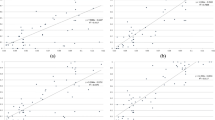Summary
In segregating populations, large numbers of individuals are needed to detect linkage between markers, such as restriction fragment length polymorphisms (RFLPs), and quantitative trait loci (QTL), limiting the potential use of such markers for detecting linkage. Fewer individuals from inbred lines are needed to detect linkage. Simulation data were used to test the utility of two methods to detect linkage: maximum likelihood and comparison of marker genotype means. When there is tight linkage, the two methods have similar power, but when there is loose linkage, maximum likelihood is much more powerful. Once inbred lines have been established, they can be screened rapidly to detect QTL for several traits simultaneously. If there is sufficient coverage of the genome with RFLPs, several QTL for each trait may be detected.
Similar content being viewed by others
References
Beckmann JS, Soller M (1983) Restriction fragment length polymorphism in genetic improvement: methodologies, mapping and costs. Theor Appl Genet 67:35–43
Bennett KL, Lalley PA, Barth RK, Hastie ND (1982) Mapping the structural genes coding for major urinary proteins in the mouse: Combined use of recombinant inbred strains and somatic cell hybrids. Proc Natl Acad Sci USA 79:1220–1224
Ellis THN (1986) Restriction fragment length polymorphism markers in relation to quantitative characters. Theor Appl Genet 72:1–2
Haldane JBS, Waddington CH (1931) Inbreeding and linkage. Genetics 16:357–374
Lalouel J-M (1979) GEMINI — A computer program for optimization of general non-linear functions. Tech Report 14, University of Utah
Lancaster HO (1969) The Chi-squared distribution. Wiley, New York
Nadeau JH, Taylor BA (1984) Lengths of chromosomal segments conserved since divergence of man and mouse. Proc Natl Acad Sci USA 81:814–818
Neinhuis J, Helentjaris T, Slocum M, Ruggero B, Schaefer A (1987) Restriction fragment length polymorphism analysis of loci associated with insect resistance in tomato. Crop Sci 27:797–803
Smith C, Simpson SP (1986) Use of genetic polymorphisms in livestock improvement. J Anim Breed Genet 103:203–217
Soller M, Beckmann JS (1983) Genetic polymorphism in varietal identification and genetic improvement. Theor Appl Genet 67:25–33
Tanksley SD, Medino-Filho H, Rick CM (1982) Use of naturally occurring enzyme variation to detect and map genes controlling quantitative traits in an inter-specific backcross of tomato. Heredity 49:11–25
Author information
Authors and Affiliations
Additional information
Communicated by L. D. Van Vleck
Rights and permissions
About this article
Cite this article
Simpson, S.P. Detection of linkage between quantitative trait loci and restriction fragment length polymorphisms using inbred lines. Theoret. Appl. Genetics 77, 815–819 (1989). https://doi.org/10.1007/BF00268332
Received:
Accepted:
Issue Date:
DOI: https://doi.org/10.1007/BF00268332




